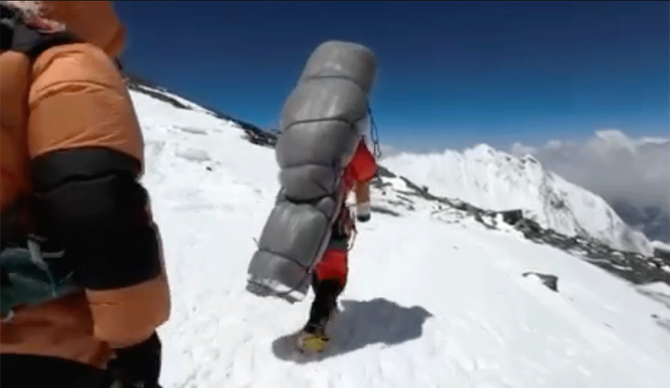
Climbing Mt. Everest is hard. Saving a climber on Mt. Everest is harder. Photo: Instagram//Gelje Sherpa
On May 18, Gelje Sherpa, a 30-year-old Everest guide, was climbing the world’s most famous mountain with a Chinese client. On the way up, he found a Malaysian man who ran into real trouble on his way down. They were in the area called the Death Zone, which is above 26,000 feet. Gelje, along with another guide named Nima Tashi Sherpa, abandoned their summit attempt to save him. When the man they rescued was safe and sound and back in Malaysia, he proceeded to thank his sponsors and block Gelje on social media.
After some outrage from the climbing community, he’s apparently unblocked him, acknowledged the fact that he saved his life, and thanked him and all the sherpas who all too often go unthanked.
The death zone is a scary place. We’re not made to survive in places that put such extreme stresses on the body. This year’s climbing season on Mt. Everest has been a particularly deadly one. Of the 478 permits Nepal has issued to climbers, at least 12 people have died. Five are still missing somewhere on the mountain. That’s the highest number of deaths in eight years.
After convincing his client that saving the man’s life was more important than reaching the 29,032-foot summit, Gelji wrapped the Malaysian man in a sleeping mat and began the near-impossible feat of getting him down to base camp. Over the next six hours, Gelji hauled him from the Balcony to the South Col. That was where Nima Tashi Sherpa joined in.
“We wrapped the climber in a sleeping mat,” Gelji said. “We dragged him on the snow or carried him in turns on our backs to camp three.”
View this post on Instagram
Rescues high up on Everest are rare. There are over 200 bodies still up there. Past 26,000 feet, the air is extremely thin and the temperature can drop to -30C or colder. Rescues are often deemed far too dangerous to attempt, as are body recoveries.
“It is almost impossible to rescue climbers at that altitude,” said Bigyan Koirala, an official from the department of tourism. “It is a very rare operation.”
Once the sherpas got the injured climber to camp three, a helicopter long-lined him down to base camp — which, as an aside, is looking pretty trashy these days.
“At the Balcony during our summit push around 8,300 meters, I saw someone in danger,” Gelje wrote on Instagram. “A man who needed rescuing and no one else was helping. I made the decision to cancel our client’s summit push so that I could bring him down to safety before he died up there alone. I carried him myself all the way down to Camp 4 where a rescue team helped from then on. I will be back up the mountain soon after regaining energy from a huge task but I am so happy to say he is alive and recovering in hospital.”
The climber was put onto a flight to Malaysia once he had recovered enough. According to reports, he then did a handful of interviews on Malaysian television, but for one reason or another, wasn’t too happy that the world was learning that he needed help. Some in the climbing community were outraged by his ungratefulness and posted memes like this:
— Everest Today (@EverestToday) June 2, 2023
Now, however, it appears that the climber has had a change of heart. “Sherpas are people who are so committed and dedicated to their clients, especially coming from 14 Peaks Expedition Co. and the Seven Summit Expedition Co.,” he tweeted. “They will never leave you behind. I experienced it this year. When descending from the summit, I had difficulty. Tashi heard that I was in trouble. He organized the rescue team (Minima Tendi, Gelje Sherpa, Nima Dorchi, Nima Tashi, Dawa Sherpa, and Dipen Bhote.) They are high altitude sherpas who make lots of sacrifices for their clients. They brought me to 7,300 meters for heli pickup for a quick heli flight to hospital.”
Gelje responded with immense humility, considering the circumstances. “Thank you,” he wrote simply. “I hope you are recovering well.”

